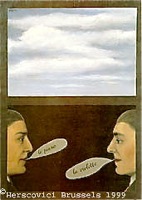Difference between revisions of "Figure of Speech"
(Created page with 'File:lighterstill.jpg A '''figure of speech''' is a use of a word that diverges from its normal meaning, or a phrase with a specialized meaning not based on ...') |
m (Text replacement - "http://" to "https://") |
||
| (One intermediate revision by one other user not shown) | |||
| Line 1: | Line 1: | ||
| − | [[File:lighterstill.jpg]] | + | [[File:lighterstill.jpg]][[File:Usespeech1928a.jpg|right|frame]] |
A '''figure of speech''' is a use of a [[word]] that diverges from its [[normal]] [[meaning]], or a phrase with a specialized [[meaning]] not based on the [[literal]] meaning of the [[words]] in it such as a [[metaphor]], [[simile]], or [[personification]]. Figures of speech often provide emphasis, freshness of [[expression]], or [[clarity]]. However, clarity may also suffer from their use, as any figure of speech introduces an [[ambiguity]] between literal and figurative [[interpretation]]. A figure of speech is sometimes called a [[rhetoric]] or a locution. | A '''figure of speech''' is a use of a [[word]] that diverges from its [[normal]] [[meaning]], or a phrase with a specialized [[meaning]] not based on the [[literal]] meaning of the [[words]] in it such as a [[metaphor]], [[simile]], or [[personification]]. Figures of speech often provide emphasis, freshness of [[expression]], or [[clarity]]. However, clarity may also suffer from their use, as any figure of speech introduces an [[ambiguity]] between literal and figurative [[interpretation]]. A figure of speech is sometimes called a [[rhetoric]] or a locution. | ||
| Line 14: | Line 14: | ||
* transferring/transposition (transmutatio) | * transferring/transposition (transmutatio) | ||
| − | These four operations were detected by [ | + | These four operations were detected by [https://en.wikipedia.org/wiki/Classical_rhetoric classical rhetoric], and still serve to [[encompass]] the various figures of speech. Originally these were called, in [[Latin]], the four operations of quadripartita ratio. The ancient surviving text mentioning them, although not recognizing them as the four fundating principles, is the [https://en.wikipedia.org/wiki/Rhetorica_ad_Herennium Rhetorica ad Herennium], of author unknown, where they are called ἔνδεια, πλεονασμός, μετάθεσις and ἐναλλαγή.[2] Quintillian then mentioned them in [https://en.wikipedia.org/wiki/Institutio_Oratoria Institutio Oratoria].[3] [[Philo]] of Alexandria also listed them as addition (πρόσθεσις), subtraction (ἀφαίρεσις), transposition (μετάθεσις), and transmutation (ἀλλοίωσις).[4]There are many examples of figures of speech. |
==External links== | ==External links== | ||
| − | * [ | + | * [https://www.uky.edu/ArtsSciences/Classics/rhetoric.html A Glossary of Rhetorical Terms with Examples] from the University of Kentucky |
| − | * [ | + | * [https://rhetoric.byu.edu/ A Guide to Rhetorical Ideas] from Silva Rhetoricae |
| − | * [ | + | * [https://niquette.com/puzzles/figurep.htm Figures of Speech] from Paul Niquette |
| − | * [ | + | * [https://humanities.byu.edu/rhetoric/Figures/Figures-Overview.htm Figures of Speech] from Silva Rhetoricae |
| − | * [ | + | * [https://www.figarospeech.com It Figures - Figures of Speech] from Jay Heinrichs |
| − | * [ | + | * [https://www.ego4u.com/en/cram-up/writing/style Stylistic Devices on English Grammar Online] from Lingo4you GbR |
| − | * [ | + | * [https://www.galilean-library.org/manuscript.php?postid=43799 Introducing Philosophy 21: Rhetoric] from Paul Newall (2005) |
[[Category: Languages and Literature]] | [[Category: Languages and Literature]] | ||
Latest revision as of 23:58, 12 December 2020
A figure of speech is a use of a word that diverges from its normal meaning, or a phrase with a specialized meaning not based on the literal meaning of the words in it such as a metaphor, simile, or personification. Figures of speech often provide emphasis, freshness of expression, or clarity. However, clarity may also suffer from their use, as any figure of speech introduces an ambiguity between literal and figurative interpretation. A figure of speech is sometimes called a rhetoric or a locution.
Not all theories of meaning have a concept of "literal language". Under theories that do not, figure of speech is not an entirely coherent concept.
Rhetoric originated as the study of the ways in which a source text can be transformed to suit the goals of the person reusing the material. For this goal, classical rhetoric detected four fundamental operations[1] that can be used to transform a sentence or a larger portion of a text. They are: expansion, abridgement, switching, transferring.
The four fundamental operations
The four fundamental operations, or categories of change, governing the formation of all figures of speech are:[1]
- expansion/superabundance/addition (adiectio)
- abridgement/lack/omission/subtraction (detractio)
- switching/interchange/substitution/transmutation (immutatio)
- transferring/transposition (transmutatio)
These four operations were detected by classical rhetoric, and still serve to encompass the various figures of speech. Originally these were called, in Latin, the four operations of quadripartita ratio. The ancient surviving text mentioning them, although not recognizing them as the four fundating principles, is the Rhetorica ad Herennium, of author unknown, where they are called ἔνδεια, πλεονασμός, μετάθεσις and ἐναλλαγή.[2] Quintillian then mentioned them in Institutio Oratoria.[3] Philo of Alexandria also listed them as addition (πρόσθεσις), subtraction (ἀφαίρεσις), transposition (μετάθεσις), and transmutation (ἀλλοίωσις).[4]There are many examples of figures of speech.
External links
- A Glossary of Rhetorical Terms with Examples from the University of Kentucky
- A Guide to Rhetorical Ideas from Silva Rhetoricae
- Figures of Speech from Paul Niquette
- Figures of Speech from Silva Rhetoricae
- It Figures - Figures of Speech from Jay Heinrichs
- Stylistic Devices on English Grammar Online from Lingo4you GbR
- Introducing Philosophy 21: Rhetoric from Paul Newall (2005)
